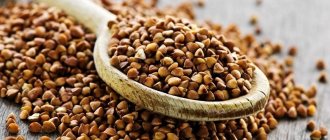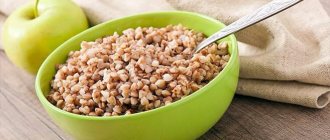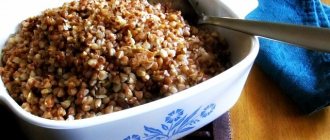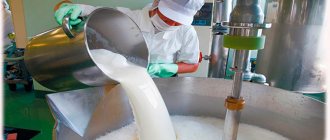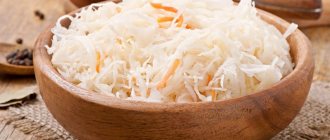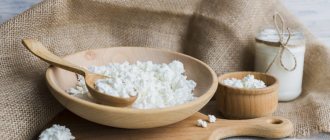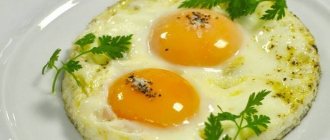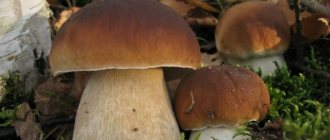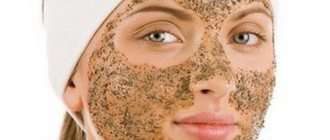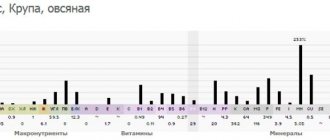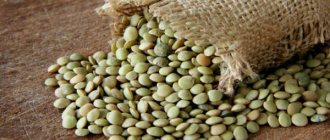- Calorie content and chemical composition
- Benefits of consumption for the body
- Harm/contraindications for use
- How much buckwheat in a tablespoon / teaspoon / glass
- Recipes and collections of food recipes
Buckwheat is an indispensable cereal in cooking, from which modern housewives prepare a lot of different dishes, it can be sweet cereals for breakfast, and meat dishes for dinner.
Few people know that buckwheat is a cereal made from buckwheat, and due to this ignorance, some confusion sometimes arises. So, buckwheat is only a derivative product from buckwheat, and we will talk about it further. Buckwheat is a genus of plants of the Buckwheat family and is used in various sectors of life, including culinary.
Buckwheat porridge with vegetables (carrots + peppers + zucchini) in the oven: see the recipe
There is an assumption that the birthplace of this plant is Northern India and it became a cultivated species about 5 thousand years ago. Before coming to Europe as a result of the Tatar-Mongol invasion, she visited China, Japan, and Korea. There is an opinion that the culture received its name from the Slavs, who called it buckwheat, since it was brought to Russia by none other than the Greeks, or rather, Greek merchants.
It is very interesting that honey can be obtained from this plant, and, more surprisingly, chocolate. No less interesting, and also useful for gardeners, is the fact that buckwheat not only is not afraid of weeds, but also displaces them from the bed where it is planted, which is why it is classified as green manure.
General information
Buckwheat is considered an environmentally friendly product, since its cultivation technology does not require the addition of chemicals during sowing. The cereal is cultivated primarily for culinary purposes [1]. However, thanks to its rich chemical composition, cereals are popular in diet therapy, medicine, cosmetology, and agriculture.
The following types of buckwheat are distinguished:
- kernel (whole grain, peeled from the outer shell);
- prodel or chaff (crushed cereal with a broken structure);
- Smolensk flakes (highly crushed grains).
Classification of buckwheat by type of heat treatment:
- fried (dark brown);
- steamed (brown);
- natural (light green).
Remember, the smaller and darker the grain, the fewer nutrients it contains [2].
Rich in amino acids and gluten free
It’s worth noting right away that gluten itself is not a villain. This cereal protein may only be dangerous for people who are sensitive to it or have an intolerance to this protein.
But thanks to its “gluten-free” nature, buckwheat porridge is breaking into the leadership of the healthiest porridges. After all, a large amount of this protein in the diet can negatively affect the health of the digestive system.
And the protein in buckwheat is complete - this means that you can get all the essential amino acids with a serving of buckwheat. Among them, the most important for you are:
- tryptophan - from it two very important hormones are formed in your body - the sleep hormone melatonin and the good mood hormone serotonin;
- You need lysine for energy and active brain function; if it is deficient, memory decreases and it is difficult for you to concentrate;
- valine is an amino acid for actively exercising, but even if you don’t have much physical activity in your life, valine helps maintain muscle and bone mass;
- Leucine – helps you feel full faster and promotes weight loss.
And so that you don’t get tired of buckwheat porridge, diversify your diet with other porridges. Either way, you'll get a lot of nutrients from healthy foods.
Chemical composition
Buckwheat is the record holder for protein content among cereals. The biological value of the crop protein is determined by the 18 amino acids present in the cereal. The highest concentrations are found in lysine, tryptophan, arginine, methionine, valine, isoleucine, and glycine.
Interestingly, in terms of protein content, buckwheat is a complete alternative to animal protein.
To supply the body with this building material, it should be present daily in the menu of athletes, vegetarians, pregnant women and the elderly. Table No. 1 “Chemical composition of buckwheat”
| Item name | Ingredient content in 100 grams of cereal, milligram [3] |
| Vitamins | |
| Tocopherol (E) | 6,65 |
| Niacin (PP) | 4,2 |
| Riboflavin (B2) | 0,2 |
| Pyridoxine (B6) | 0,4 |
| Thiamine (B1) | 0,43 |
| Folic acid (B9) | 0,032 |
| Beta-carotene (A) | 0,002 |
| Macronutrients | |
| Potassium | 380 |
| Phosphorus | 298 |
| Magnesium | 200 |
| Sulfur | 88 |
| Chlorine | 33 |
| Calcium | 20 |
| Sodium | 3 |
| Microelements | |
| Silicon | 81 |
| Iron | 6,7 |
| Zinc | 2,03 |
| Manganese | 1,56 |
| Copper | 0,64 |
| Bor | 0,35 |
| Titanium | 0,034 |
| Molybdenum | 0,033 |
| Fluorine | 0,023 |
| Nickel | 0,0101 |
| Selenium | 0,0083 |
| Chromium | 0,004 |
| Iodine | 0,0033 |
| Cobalt | 0,0031 |
The nutritional value of buckwheat includes (per 100 grams):
proteins – 13.5 grams;- fats – 3.4 grams;
- carbohydrates – 61.5 grams;
- water (14 grams);
- organic acids (0.2 grams);
- dietary fiber (11.3 grams) [4];
- starch (55.4 grams);
- unsaturated fatty acids (2.28 grams);
- mono- and disaccharides (1.5 grams);
- saturated fatty acids (0.67 grams);
- amino acids (10.32 grams);
- sterols (0.074 grams)
- ash (2.1 grams);
- purines (0.06 grams).
The calorie content of a product directly depends on the cooking method. Thus, dry (sprouted) grain contains 330 kilocalories per 100 grams of product, boiled cereal - 150 kilocalories, steamed kernels - 250 kilocalories.
Considering that the cereal does not contain gluten (gluten), buckwheat is of particular value for people suffering from celiac disease.
Beneficial features
The effect of cereal on the human body [5]:
Reduces the risk of developing malignant tumors (due to the content of natural antioxidants) [6].- Increases the body's resistance to adverse environmental factors, including radiation (folic acid strengthens the immune system, potassium and iron prevent the absorption of radioactive isotopes).
- Accelerates the healing of the gastric mucosa (tannins contained in cereals have an anti-inflammatory effect).
- Potentiates the synthesis of hemoglobin, as a result of which the rheological parameters of the blood improve (due to the presence of iron).
- Prevents the occurrence of thrombosis (unsaturated fats prevent the adhesion of cholesterol plaques to the walls of blood vessels).
- Improves psycho-emotional state, prevents sleep disorders (due to the presence of tryptophan, magnesium, B vitamins).
- Stabilizes blood sugar concentrations (has a low glycemic index of 40).
- Prevents hormonal dysfunctions by supplying the body with essential substances (vitamins, amino acids, micro- and macroelements).
- Increases potency in men (zinc stimulates testosterone production).
- Reduces blood pressure, normalizes the contractile function of smooth muscles (magnesium controls these processes).
- Strengthens the nervous and immune systems, helps in the fight against insomnia, migraines, headaches (thanks to the presence of rutin and B vitamins).
- Stimulates intestinal motility, relieves constipation, and “supplies” dietary fiber to the body.
- Seals the walls of blood vessels, increases the elasticity of veins (rutin, which cereal is rich in, has a pronounced capillary-protective effect) [7].
- Strengthens bone tissue, including teeth and nails (due to the phosphorus and calcium content).
- Maintains osmotic pressure in the cell, accelerates the removal of excess fluid from the body (these mechanisms are “under the control” of potassium).
- Stabilizes heart rhythm, improves myocardial function, prevents the development of coronary disease (magnesium contained in buckwheat normalizes the neuromuscular activity of the heart).
- Protects the liver from fatty infiltration (due to the presence of lipotropic substances in the cereal).
In addition, with regular consumption of buckwheat, the functional state of the dermis, hair, and nails improves.
What substances are missing in the body if you want buckwheat?
Probably everyone at least once in their life has experienced a strong desire to eat a plate of delicious crumbly porridge with butter. Nutritionists note that this is not always just a gastronomic whim. Such a desire may indicate that the human body lacks iron or magnesium. In addition, this may indicate a lack of B vitamins or the required amount of protein.
Did you know? A popular belief says that an irresistible desire to eat buckwheat porridge indicates pregnancy. However, this statement has no medical evidence.
Application in medicine
Considering that buckwheat contains a wide range of useful substances, it is successfully used in folk medicine. To prepare medicinal potions, whole, unroasted cereal grains (green), as well as leaves and shoots of buckwheat, are used.
Traditional recipes:
A mixture for stagnation of bile, high sugar, pancreatitis, poisoning. To prepare the composition you will need 15 grams of buckwheat flour and 250 milliliters of low-fat kefir. The first ingredient is obtained by grinding cereals in a coffee grinder, and the second is obtained by fermenting homemade milk. Both products are combined and left in the container overnight. The resulting mixture is eaten for breakfast. The duration of choleretic therapy is 1 month. After 30 days the course is repeated.- A remedy for anemia, chronic fatigue, weakness. Before creating the potion, the cereal is washed and then dried in a frying pan. After this, the kernel is ground in a coffee grinder. Buckwheat flour is taken 30 grams 4 times a day, in between meals.
To enhance the therapeutic effect, the powder is washed down with warm milk. Use the product for at least 30 days (until the condition improves). If necessary, after a month's break the course is repeated.
- Buckwheat jelly to strengthen the cardiovascular system and prevent atherosclerosis. The composition of the healing product includes 45-50 grams of cereal (pre-crushed in a coffee grinder) and 250 milliliters of water. Combine these ingredients and mix thoroughly. After this, the mixture is poured in a thin stream into a liter of boiling water. The jelly is simmered over low heat for 10 minutes. Take buckwheat mixture 3 times a day, 200 milliliters.
- Healing ointment for abscesses, boils, and difficult-to-heal wounds. Crushed buckwheat (45 grams) is combined with a decoction of celandine (50 milliliters). The healing mixture is applied to the affected area three times a day for 10 minutes.
- Buckwheat sprouts for healing the body. The grain is rinsed with clean water and then placed on damp gauze. The container with the raw materials is placed on the windowsill. Considering that green buckwheat secretes a lot of mucus, the fabric and cereal are washed daily with water. With proper care, seedlings appear on the 2nd day. For medicinal purposes, slightly “hatched” grain (1-4 millimeters) is used [8].
Remember, the length of the sprouts should not exceed 1 centimeter.
Indications for use: anemia, obesity, vitamin deficiency, inflammation of the gallbladder, arthritis, pathologies of the organs of vision, atherosclerosis, coronary heart disease, varicose veins [9].
- Powder for babies. The crushed buckwheat kernels are sifted through a fine sieve. The resulting powder is used for the prevention and treatment of diaper rash in children (in the absence of lycopodium).
Contraindications
Buckwheat has no contraindications, but there are some restrictions regarding its combination with other products, such as dairy. Buckwheat contains a lot of iron, and milk is rich in calcium. In combination, these two minerals are poorly absorbed and do not bring benefits. In addition, such a tandem can lead to bloating and indigestion.
Buckwheat is rich in vitamins, macro- and microelements, plant fibers and protein. It is useful for the functioning of the digestive, nervous, circulatory, and genitourinary systems, and has an antioxidant effect. Properly prepared porridge quickly fills you up and promotes weight loss.
Rate this article 3.8333333333333 3.8 (3 ratings)
Application in cosmetology
Buckwheat, along with improving the health of the body, has a beneficial effect on the skin (nourishes, rejuvenates, cleanses, normalizes cellular metabolism). Due to the content of vitamins, phytohormones, organic acids and fats, the cereal is actively used in professional cosmetics, as well as for the preparation of homemade masks, creams and scrubs. Homemade mixtures with buckwheat are ideal for caring for combination, normal and sensitive skin.
Cereal based home remedies:
Nourishing mask for dry and normal skin. Ingredients: 30-60 grams of buckwheat flour, 20 milliliters of olive oil. The mask is applied to previously cleansed, damp skin of the face, neck and décolleté for 20-30 minutes. After completing the procedure, the mixture is washed off with warm water.- Toning mask for oily and combination skin. Method of preparation: mix grated carrots (1 piece), 30 grams of buckwheat flour, 2 milliliters of lemon juice. Apply the paste mixture to the dermis for 20 minutes, rinse.
With regular use of the composition (three times a week), the complexion improves, the capillaries are strengthened, and the oily sheen disappears.
- Film mask for problematic and sensitive skin. To prepare the product you will need 100 milliliters of chamomile infusion. 15 grams of edible gelatin and 20 grams of buckwheat flour are dissolved in it. The prepared mixture is heated to 70 degrees and then cooled. After this, add 15 milliliters of fresh aloe juice (or cucumber) to the mask. Leave the mixture on your face for 20 minutes and then carefully remove it with your hands. A film mask is used to cleanse and narrow pores, reduce acne, activate blood circulation, and deeply moisturize the dermis. It is suitable for all skin types.
- Mask against rosacea. Active ingredients: buckwheat flour (15 grams), one chicken yolk, honey (5 milliliters). The ingredients are thoroughly mixed and applied to the dermis in a thin layer. After 15 minutes, the mixture is washed off. The mask has a capillary-protective, anti-inflammatory and strengthening effect on the skin.
- Compresses for eyes against swelling. Buckwheat is pre-crushed and distributed into two gauze bags. Before use, immerse them in hot water for 4 minutes (to steam), then cool. After this, apply compresses to your eyelids for 15 minutes.
This mask is used to eliminate puffiness under the eyes, smooth out fine wrinkles, and deeply nourish the dermis.
- Body Scrub. Buckwheat flour (15 grams), coffee grounds (15 grams), mint or chamomile infusion (100 milliliters) are combined and stirred thoroughly. The mixture is applied to a washed body, intensively massaging problem areas.
The scrub perfectly removes dead skin cells of the epidermis, cleanses and tones the skin, and reduces the severity of cellulite.
- Nourishing hair mask. To create the mixture, prepare: 30 grams of buckwheat flour, 100 milliliters of warm homemade milk, 1 egg, 10 milliliters of honey. The composition is mixed and applied to clean hair for 30-40 minutes. After the specified time, wash off the mask with hot water and shampoo. The product nourishes and strengthens thin and unruly hair.
To enhance the cosmetic effect, after completing the procedures, a nourishing cream is applied to the skin.
Buckwheat for weight loss
Despite its high energy value, buckwheat has a low glycemic index. This is an absolutely dietary product, on the basis of which many weight loss schemes, fasting days and food rations have been compiled [10].
The effectiveness of buckwheat diets is due to the prolonged breakdown of the grain in the stomach, which dulls feelings of hunger. At the same time, the body is forced to provide itself with nutrients by burning fat reserves from the depot. As a result, metabolism accelerates, and a person loses excess weight faster. In addition, cereal contains many useful elements that help a person lose weight while maintaining a good mood, strong nails, healthy skin and thick hair.
The buckwheat diet is easy to use, as it contains cereals and water. The duration of mononutrition varies from 3 to 14 days (depending on the goals). A three-day weight loss scheme is classified as fasting days. It helps the body cleanse itself of toxins and burn up to 1.5 kilograms of excess weight. To eliminate 5 to 10 extra pounds, the buckwheat diet is extended to 14 days.
How to cook cereal correctly?
Buckwheat is steamed in the evening for the entire next day. To do this, 300 grams of washed kernels are poured with a liter of boiling water. The vessel is wrapped in a blanket and left for 10-12 hours on the stove.
Remember, adding sugar, salt or seasonings to a dietary dish is strictly prohibited.
If the mono-diet is poorly tolerated, it is recommended to use a milder version of the technique and include kefir in the diet.
Acceptable power schemes:
- Pour 350 grams of buckwheat with a liter of low-fat kefir. Leave the porridge for 10 – 12 hours in a warm place. Throughout the day, consume only the resulting mixture.
- In the morning, lunch and evening, eat exclusively steamed buckwheat, and during snacks, consume 250 milliliters of low-fat kefir. The daily intake of fermented milk drink is 1-1.5 liters.
The duration of the kefir-buckwheat diet should not exceed 14 days.
To consolidate the result, return to your previous diet gradually. In the first 4 days of “going out”, in addition to buckwheat, eat only easily digestible foods (fruits, low-calorie yogurt, kefir, honey, vegetable salads, greens), and then gradually increase the calorie content of the diet to normal.
Contraindications to the use of the buckwheat diet: gastritis, stomach ulcers, duodenal erosion, diabetes mellitus, intestinal disorders, hypertension, pregnancy, lactation, old age and adolescence.
